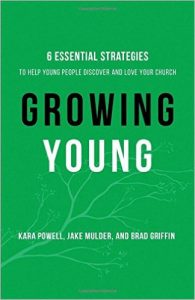 I recently had the opportunity to not only read Growing Young, but to hear one of the authors, Jake Mulder, speak to a group of executive pastors for which I am the facilitator. I’ve been part of countless conversations in which the overarching question is, “How can our church reach young adults?” I’m thankful that Jake, along with co-authors Kara Powell and Brad Griffin, offer practical, research-based answers to this question.
Growing Young is an outgrowth of the Fuller Youth Institute and their work on “sticky faith.” It is based on a 4-year research project that began with 363 congregations, seeking to identify ones that “are really good at reaching young people” and understanding what they are doing differently. They define “young people” as being between 15 and 29 years old.
The central findings of Growing Young are summarized in 6 core commitments that emerged from the research. These commitments are:
I recently had the opportunity to not only read Growing Young, but to hear one of the authors, Jake Mulder, speak to a group of executive pastors for which I am the facilitator. I’ve been part of countless conversations in which the overarching question is, “How can our church reach young adults?” I’m thankful that Jake, along with co-authors Kara Powell and Brad Griffin, offer practical, research-based answers to this question.
Growing Young is an outgrowth of the Fuller Youth Institute and their work on “sticky faith.” It is based on a 4-year research project that began with 363 congregations, seeking to identify ones that “are really good at reaching young people” and understanding what they are doing differently. They define “young people” as being between 15 and 29 years old.
The central findings of Growing Young are summarized in 6 core commitments that emerged from the research. These commitments are:
- Unlock keychain leadership – empowers others, especially young people.
- Empathize with today’s young people – step into the shoes of this generation.
- Take Jesus’ message seriously – welcome young people into a Jesus-centered way of life.
- Fuel a warm community – aim for warm peer and intergenerational friendships.
- Prioritize young people everywhere – look for creative ways to tangibly support, resource, and involve them in all facets of your congregation.
- Be the best neighbors – enable young people to neighbor well locally and globally (Growing Young, p. 43).



